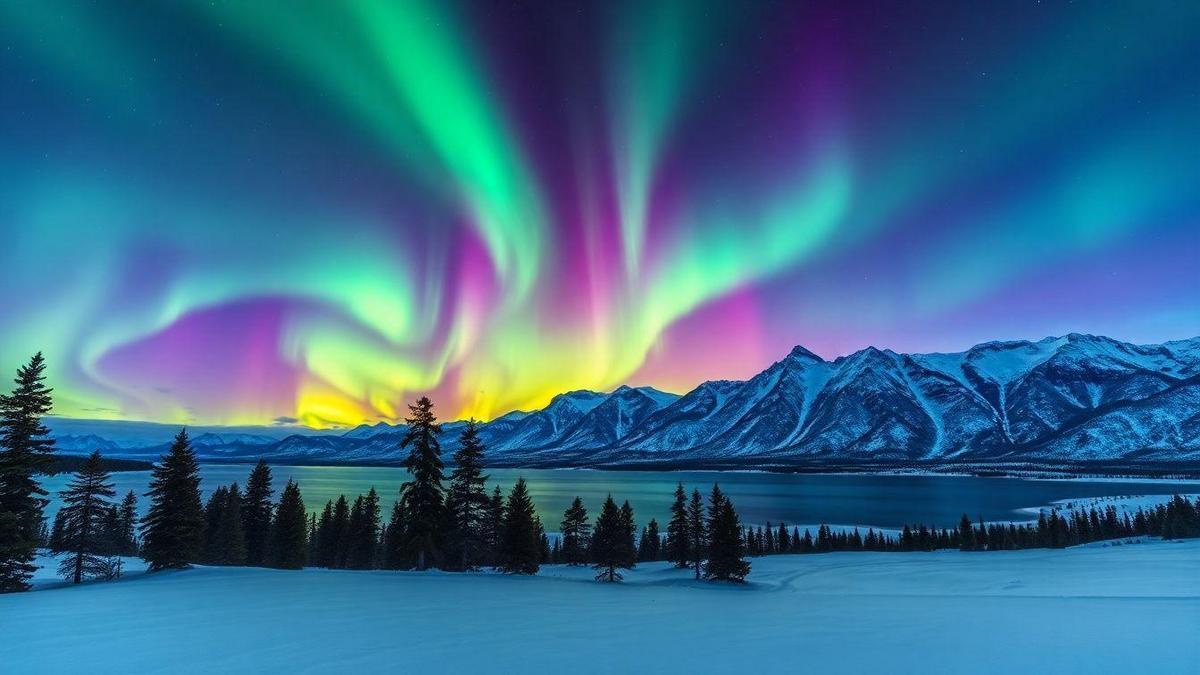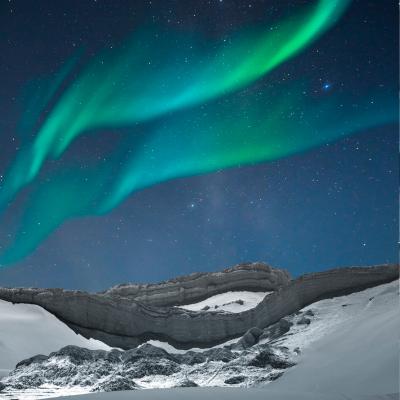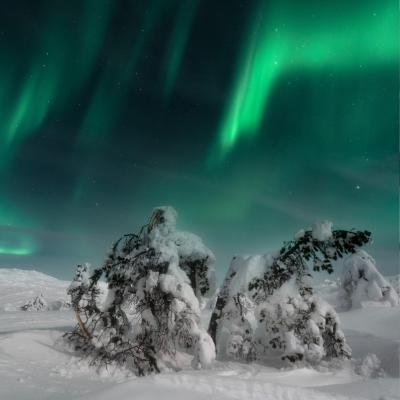Anúncios
Polar auroras are fascinating natural phenomena that occur in regions closest to Earth’s poles. Also known as the Northern and Southern Lights, these light displays originate from interactions between solar wind and Earth’s magnetic field. When solar particles enter the atmosphere, they collide with gases, producing the vibrant colors that characterize the auroras.
Studying the auroras provides a unique view of the dynamics between the Sun and Earth, revealing how solar activity can affect our planet. In addition to their stunning beauty, these phenomena are important for scientific research and space weather forecasting, as well as inspiring various cultural and artistic expressions throughout history.
Anúncios

What are the Polar Auroras?
Polar auroras, also known as the Northern and Southern Lights, are luminous phenomena visible in the skies of regions near Earth’s poles. They are caused by the interaction between charged particles emitted by the Sun and Earth’s magnetic field. When these particles enter Earth’s atmosphere, they collide with oxygen and nitrogen molecules, generating the colored lights.
The visual display created by auroras can present different colors, such as green, purple, and red, depending on the composition of the atmosphere and the altitude at which they occur. This phenomenon is more common in regions close to the magnetic poles, where Earth’s magnetic field lines guide the solar particles. The luminous dance of the auroras is one of the most beautiful manifestations of the interaction between Earth and the Sun.
Throughout the centuries, polar auroras have always sparked human imagination. Different cultures and civilizations have tried to understand the meaning of these mysterious lights, often creating myths and legends about their origin. Today, with scientific advancements, we know that auroras are a natural phenomenon resulting from complex physical processes.
Auroras can be observed in various places on the planet, especially at high latitudes in the northern and southern hemispheres. During certain periods of increased solar activity, auroras can be seen more intensely, making the experience even more impressive for observers.
How Do Polar Auroras Form?
Polar auroras are generated by charged particles, such as electrons and protons, emitted by the Sun. These particles are part of the solar wind, a constant flow of particles traveling through space. When the solar wind reaches Earth, it interacts with Earth’s magnetic field, creating a kind of natural “shield.”
Earth’s magnetic field directs solar particles toward the magnetic poles, where they enter the Earth’s atmosphere. When they collide with gases in the atmosphere, mainly oxygen and nitrogen, energy is released, resulting in the characteristic colors of the auroras. The intensity of the phenomenon can vary depending on the number of solar particles and the altitude of the collisions.
The physical process behind the auroras is a visual manifestation of space weather dynamics. When there is increased solar activity, such as solar eruptions or coronal mass ejections, the number of particles and the energy released increase, intensifying the auroras. This primarily occurs during periods of solar maximum, which happen approximately every 11 years.
The formation of auroras is also related to variations in Earth’s magnetic field intensity. During geomagnetic storms, when the magnetic field is more disturbed, auroras can extend to lower latitudes, becoming visible in places that are usually not affected.
The Best Places to Observe Auroras

The best regions to observe polar auroras are located near Earth’s magnetic poles. In the northern hemisphere, places such as Norway, Sweden, Finland, Canada, and Alaska are ideal for seeing the lights. These locations offer access to clear skies and visibility of the auroras, especially during the winter months.
In addition to high latitudes, the choice of location for observation should also consider the quality of the sky. The ideal place is one with little light pollution, such as rural areas or national parks. Clear, cloudless skies are essential to ensure a perfect view of the natural phenomenon.
The season also plays a key role in observing the auroras. The best conditions for seeing them occur during the winter months, from September to March. During this period, the nights are long, and the sky tends to be darker, increasing the chances of seeing the auroras clearly.
Although auroras are most visible at higher latitudes, they can be seen further south during periods of high solar activity. However, the further north or south you are, the higher the chances of observing the auroras with intensity.
How Do Polar Auroras and the Magnetic Dance Between the Sun and Earth Work?
Polar auroras, also known as the Northern and Southern Lights, are one of nature’s most mesmerizing phenomena. These dazzling light displays are created when charged particles emitted by the Sun collide with Earth’s magnetic field and atmosphere. The interaction between the solar wind, a flow of charged particles released by the Sun, and Earth’s magnetic field creates a luminous spectacle in the polar regions. This process is not only visually impressive but also a complex interplay of solar and terrestrial forces that scientists have studied for decades.
Earth’s magnetic field acts as a shield, protecting us from the harmful effects of solar radiation. However, during periods of intense solar activity, such as solar eruptions or coronal mass ejections, the intensity of the solar wind increases. When these charged particles reach Earth, they are directed toward the polar regions by the magnetic field lines. Upon entering the atmosphere, they collide with gas molecules, mainly oxygen and nitrogen, resulting in the vibrant colors that characterize the auroras. The colors vary depending on the type of gas and the altitude at which the collisions occur, leading to the beautiful greens, purples, and reds that we see in the night sky.
Advantages of Understanding Polar Auroras and the Magnetic Dance Between the Sun and Earth

Understanding the polar auroras and the magnetic dance between the Sun and Earth offers several benefits, both for scientific research and practical applications. First, studying the auroras provides insights into the dynamics of the solar wind and its interaction with Earth’s magnetic field. This knowledge is crucial for improving space weather forecasting, helping to protect satellites, electrical grids, and communication systems from the potentially damaging effects of solar storms. By monitoring solar activity and its impact on Earth, scientists can provide early warnings and mitigate risks associated with these natural events.
Moreover, exploring the science behind the auroras enhances our understanding of fundamental physics and atmospheric science. The study of auroras involves various scientific disciplines, including astrophysics, geophysics, and atmospheric chemistry. This interdisciplinary approach fosters collaboration among scientists and encourages the development of new technologies and methodologies for studying complex natural phenomena. As researchers delve deeper into the mechanisms behind auroras, they uncover valuable information that can be applied to other areas of science and technology.
Additionally, understanding the polar auroras can have cultural and educational benefits. These impressive light displays have inspired countless myths, legends, and artistic expressions in different cultures. By educating the public about the science behind auroras, we can foster a greater appreciation for the natural world and inspire future generations to pursue careers in science, technology, engineering, and mathematics (STEM). This awareness can lead to greater support for scientific research and conservation efforts aimed at protecting our planet.
Finally, studying the polar auroras can also contribute to our understanding of climate change and its impacts on Earth’s atmosphere. As we learn more about the interactions between solar activity and Earth’s magnetic field, we can gain insights into how these processes might be affected by human-induced environmental changes. This knowledge is essential for developing strategies to mitigate the effects of climate change and protect our planet for future generations.
How to See and Appreciate Polar Auroras and the Magnetic Dance Between the Sun and Earth
Observing and appreciating the polar auroras is an unforgettable experience that requires careful planning. To maximize your chances of witnessing this natural wonder, it’s essential to choose the right location for observation. The best places to see auroras are generally located in high-latitude regions, such as Norway, Sweden, Finland, Canada, and Alaska. These areas are near the magnetic poles, where auroras are most commonly observed. Researching local aurora forecasts and historical data can help identify the best viewing spots.
Timing your visit during periods of solar activity is also crucial for experiencing the polar auroras. The Sun goes through a roughly 11-year solar cycle during which solar activity fluctuates. Periods of high solar activity, known as solar maximum, are when auroras are most likely to occur. Monitoring reports on solar weather and aurora forecasts can help you plan your trip during the best times for aurora displays.
Dressing appropriately for the cold is essential when heading out to see the auroras. Polar regions can experience extreme temperatures, and being prepared with the right clothing can make your experience much more enjoyable. Layering is key; wear thermal layers, insulated jackets, and waterproof outer layers to stay warm and comfortable while waiting for the auroras to appear.
Using a camera to capture the beauty of the polar auroras is another way to enhance your experience. These stunning displays can be challenging to photograph, but with the right equipment and techniques, you can create lasting memories of your adventure. A tripod, a camera with manual settings, and a wide-angle lens are essential for capturing the vibrant colors and dynamic movements of the auroras. Experimenting with long exposure times can also help you capture the ethereal beauty of these natural light shows.
Staying informed about weather conditions is vital for the success of aurora viewing. Clear, dark skies offer the best visibility for observing auroras, so checking local weather forecasts and cloud cover predictions can help you plan your outings. Additionally, respecting the local nature and wildlife while observing the auroras is important. Keeping a safe distance from wildlife and minimizing your impact on the environment ensures that future generations can enjoy the beauty of the polar auroras.
In conclusion, observing and appreciating the polar auroras is a rewarding experience that requires careful planning and consideration of various factors. By choosing the right location, timing your visit during solar activity, dressing appropriately, using a camera, staying informed about weather conditions, and respecting nature, you can increase your chances of witnessing these breathtaking natural displays.
Did You Enjoy Learning About the Polar Auroras and the Magnetic Dance Between the Sun and Earth?
Learning about the polar auroras and the magnetic dance between the Sun and Earth opens up a world of wonders and curiosity. The intricate relationship between solar activity and Earth’s atmosphere is not only fascinating but also essential for understanding various aspects of science and technology. As we continue to study these phenomena, we uncover new insights that can benefit society as a whole.
If you found this exploration of the polar auroras intriguing, consider diving deeper into the subject. There is much more to discover about the science behind these beautiful light displays and their impact on our planet. Engaging with this topic can inspire a greater appreciation for the natural world and motivate you to explore more of the wonders of our universe.
Frequently Asked Questions
What are the polar auroras?
Polar auroras are colorful lights that appear in the sky. They occur at the northern and southern poles of Earth.
How do polar auroras form?
They form when particles from the Sun collide with Earth’s atmosphere. This “magnetic dance” creates the lights.
When can I see the polar auroras?
You can see the polar auroras mainly during the winter. The best months are from September to March.
Where are the best places to see the auroras?
The best places are in Norway, Sweden, Finland, Canada, and Alaska. They are near the Arctic Circle.
Do the polar auroras affect Earth?
Yes, they can affect communication systems and GPS. But, they are also beautiful to see!
